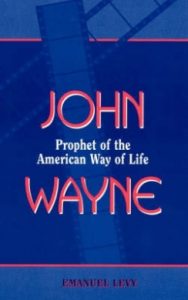John Wayne contributed extensively to two distinctly American genres: the Western and the war film. Although he did not make as many war movies as Westerns, the former played an important role in his career and contributed immensely to his screen image and popularity.
Note:
If you want to know more about John Wayne’s career and life, please read my book:
Wayne was anxious to make war films because of personal frustrations. He was too young (seven) to take part in the First World War, and too old (34) to fight in the Second World War. In addition to age, Wayne was draft-exempt for having family commitments; he was married and had children, and an injury from playing football at the University of Southern California. Even the connections of John Ford, who during the War was Chief of the Field Photographic Branch at the OSS with the rank of lieutenant commander in the Navy, did not help to get him drafted.
Wayne’s frustration grew when many stars of his generation were enlisted. Jimmy Stewart was the first big Hollywood star to enlist into military service, on March 21, 1941, even before the United States joined the War. Stewart went out of his way to get drafted, much to the disappointment of MGM. Deferred by the board for being underweight, Stewart had to put on ten pounds. His enlistment got tremendous publicity, especially the drastic pay cut he had to take. The difference between his monthly military remuneration and his Hollywood income amounted to $11,979. Stewart did not make any film for five years, during which he flew missions over Germany as a bomber pilot, rising in rank from private to Colonel.
Many stars then followed Stewart. Clark Gable enlisted into the Air Force in 1942, after the death of his wife-actress Carole Lombard in an air-crash accident. He too achieved the high rank of a Major for flying bombing missions over Germany. Henry Fonda was also enlisted into service in the Navy in 1942, serving as an assistant operations and air combat intelligence officer in the Pacific. All of these actors were singled out for their patriotic services. Gable received the Distinguished Flying Cross and Air Medal, and Fonda was awarded a Bronze Star and a Presidential citation. Stewart retired from the Armed Services in 1968, as a Brigadier General in the Air Force Reserve, the highest-ranking entertainer in the U.S. military.
Realizing that he could not take part in the “real” action, Wayne immersed himself in making flag-waving war pictures. What contributed to his interest in this genre was the fact that by 1941 most Hollywood stars have already made war movies, which was important to their careers as well as to the nation’s morale.
Robert Taylor made “Flight Command,” the story of Fight Squadron Eight, at MGM in 1940, and a year later, Ray Milland and William Holden appeared in “I Wanted Wings”; Tyrone Power in “Yank in the R.A.F.”; and Errol Flynn in “Dive Bomber.”
Moreover, Gary Cooper’s performance in “Sergeant York” not only won his first Oscar Award, but the film itself enjoyed extraordinary popularity as the top-money-making picture of 1941, grossing six million dollars in domestic rentals.
Their studios used actors not drafted most efficiently, to make up for the shortage in male stars. James Cagney and Humphrey Bogart reached new heights of popularity at Warner during the War, and Spencer Tracy became MGM’s biggest star and most employed actor; Clark Gable and Robert Taylor, the studio’s other stars, were drafted.
Errol Flynn also continued to do his heroics in adventure and costume pictures, though, ironically, he was classified 4F and was turned down by every branch of the Armed Forces because of a combination of a heart defect, recurrent malaria, and a measure of tuberculosis. This rejection hurt his ego and was concealed from the public for fear of bad publicity.
During the Second World War, the Western film declined in popularity. Historians estimate that about one third of the films produced in Hollywood (500 out of 1700), between 1942 and 1945, were about some aspect of the War: the battle or the home front. Wayne, like other stars, had to switch from playing cowboys to playing soldiers.
Broadly defined, Wayne made sixteen war pictures (about ten percent of his film output) beginning with Three Faces West, in 1940, all the way to The Green Berets, in 1968.
Most of these pictures, such as “Sands of Iowa Jima” and “The Longest Day,” dealt with the Second World War and with good reason: it was the last American war that was unanimously perceived as a “good” war for a noble cause.
By contrast, Wayne did not make any movie about the divisive Korean War, which is a revealing omission from his repertoire.
However, he was the first filmmaker to treat the Vietnam War on the screen in “The Green Berets,” one of his most propagandistic pictures.
Other Wayne pictures, such as “Pittsburgh,” used the War as a background, but they were not typical genre movies.











